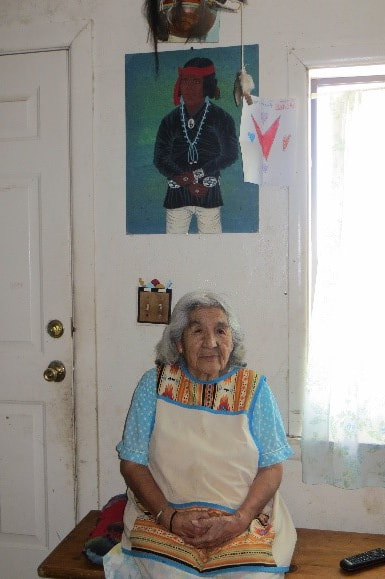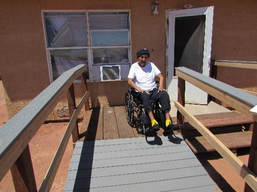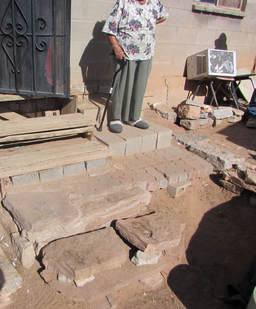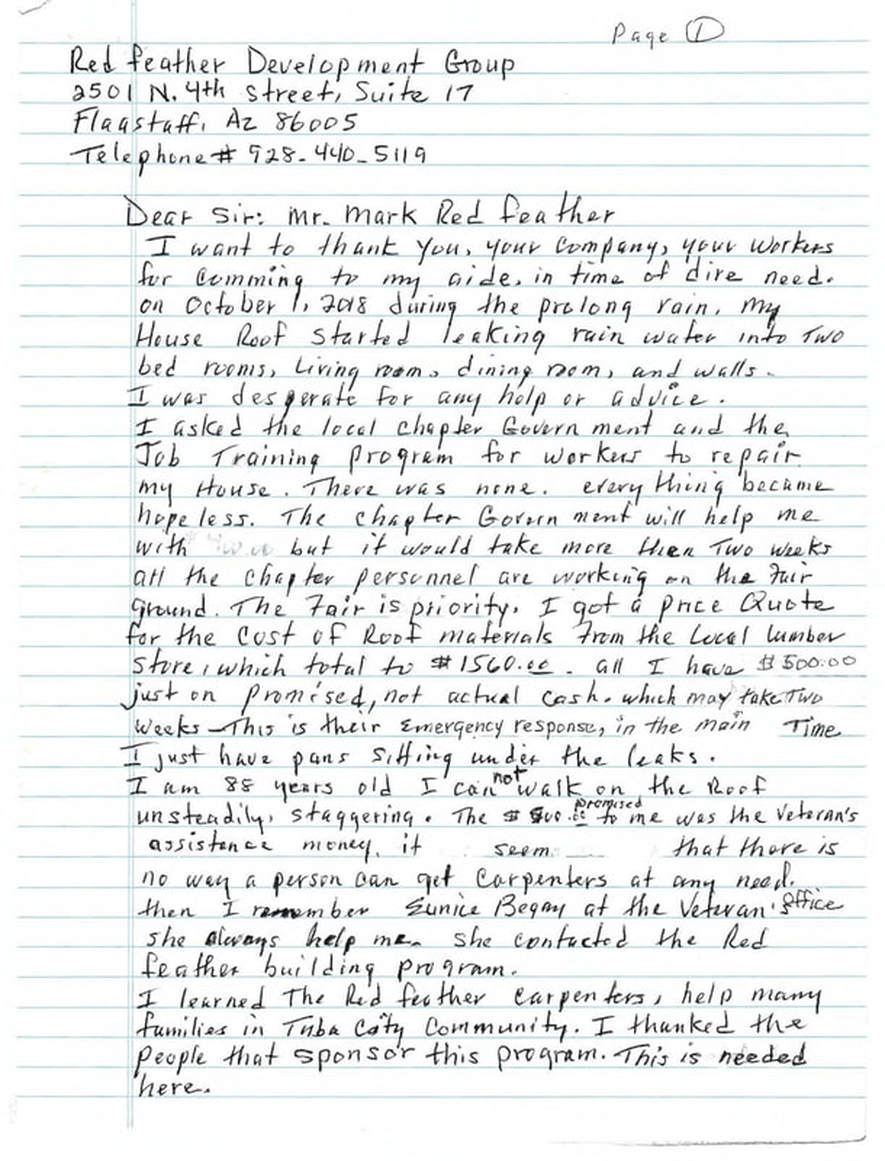From the Ground: Aging in Place  Aging in Place Program Coordinator Kayla Miller shares her vision for the program as Red Feather looks to support tribal elders living safely in their homes. Aging in Place is one of our newest programs, furthering Red Feather’s mission of meeting housing needs for people on the Hopi and Navajo Nations in the ways they define as most needed. After receiving seed funding from the Kendal Charitable Trust in 2018 to start providing more specific aging in place services, Red Feather’s elder-focused services have continually expanded. What has been the biggest success of the aging in place programs so far? The way we’ve been able to make the aging in place program work with our other, wide-reaching programs, like our APS weatherization program. Case-managers go to homes for weatherization audits which allows us to see what elders actually need. Not everyone needs all the aging in place items we offer. Some elders don’t have full showers so a shower chair might not work for them. Some desperately needs ramps while others are more affected by temperature extremes. Our case-management style of working with people, and going on audits to weatherize homes, allows us to actually meet people where they are and hear from them directly about what they need. Where would you like to see the program go? I would like to see more of in-home meeting with clients. With the new field positions based in Hopi and Navajo, we are hoping we will be able to increase the amount of people getting direct in-home audits. This allows us to just really see where elders are at on an individual level. I also want to see us advertising this program more, which is a work in progress. I think there are lots of elders out there that could benefit that we haven’t reached yet. I’ve heard from multiple people: “This is just what I needed, I didn’t even know you did this! Thank you so much!” So yes, we will be ramping up awareness of the program as we get more funding for aging in place kits. A lot of people are on disability or social security- so they go there first for resources, but these programs can’t always meet all their aging in place needs, and definitely can’t go into people’s homes like we do. Red Feather is a great resource for people so we just want to get the word out. What have you seen as far as the extent of the need for elder support and aging in place? How needed do you think these sorts of supports are? The need is definitely there. I hear things from clients like “I fell down the other day because I didn’t have anything to grip onto in my tub” or that they fell down their stairs because there wasn’t a railing. Elder falls is a high cause of admittance into a hospital, so we know that this is a huge need in the community. One client mentioned how something as simple as a toilet riser has made her life so much easier because her knees are really bad. These little things here and there make a big difference to people. She was so grateful for that and the other aging in place items we gave her. People are really, really grateful. What’s your favorite thing about working with people in this capacity? People on the reservation are really vocal about what they want and need. Which is great! Right now funding is limited so we can’t always give everyone who needs one a fully remodeled walk-in shower, but still, that meeting people one-on-one and getting to know them, that is what allows us to help make a home that works for them. One recipient had recently gone through hip surgery, and she had a really high bathtub – and the second I walked in the door she was right on it- showing me everything she needed and telling me what was going on with her. Her son helped her set up all the aging in place items we gave her. She was actually shocked that we provided her with all the items she needed. When I went back to see her she was just effusive and so grateful- and showed us everything set up in her home. I mean, that’s amazing to be able to see that change firsthand in someone’s life. Why does this work matter? With elders, especially Native American elders, they’re very home-based. For the most part the homes they are living in now are the homes they’ve always known. So if they aren’t able to move around or do things in their homes, they obviously get really down. Its demoralizing. With these kits for elders, we are able to help them age in place comfortably. They are in their own homes, they can do things for themselves. They are still a part of their communities. All our recipients so far have been so grateful. We can’t always honor all their requests, but we do the best we can. A lot of elders live alone. The peace of mind for the family knowing they are safer in their homes also matters a lot. The positive feedback shows how great this program is. These little things truly matter. What are your hopes and dreams for these initiatives? What would you love to provide for elders? Money for ADA accessible walk-in showers! These are expensive, but people need them. I have noticed a bigger interest in this along with wheelchairs and walkers too. These items are expensive. I would love to have funding for these bigger cost/bigger impact items. This would definitely provide a positive impact in the lives of our clients. Being able to create a healthy and safe home is our vision and we are hoping to expand our outreach. I can’t wait to see the program grow! Eleanor is always smiling and has many stories to tell. She is quiet, reserved and prefers to speak in Navajo. While on home visits, she is very kind and doesn’t hesitate to teach Navajo words and phrases to our Red Feather Staff. Her home needed weatherization work and Aging in Place adaptations. Red Feather programs were able to install weather strips, seal gaps, caulk priority air leaks, install a heat pump, a smoke detector, a water saving faucet and 10 LED light bulbs as well as a mini-split for heat and AC. Prior to the mini split, she utilized a wood stove and had no AC. Thanks to the mini split, she can now turn on the AC or heat with the touch of a button. Eleanor also has mobility issues that make it hard for her to get around easily. Thanks to the Aging in Place program, she got a toilet riser, shower tub handrail, and a kit that includes an ice pack, night lights, non-slip rugs and a handheld shower head. These products aid elderly clients to comfortably get around their home. “I am very thankful for the work that has been done” Eleanor says. “The (minisplit) unit that was installed keeps my home nice and cool… I no longer get headaches from the heat, I feel a lot better”. Thank you to Red Feather Partner Cozyhome for their work on this project. “I am very thankful for the work that has been done” Eleanor says. “The (minisplit) unit that was installed keeps my home nice and cool… I no longer get headaches from the heat, I feel a lot better”. Story by Shannon Maho, Program Coordinator I have known about Red Feather for more than five years, and have been the Program Coordinator for the last year. Prior to being a Red Feather staff member, I was a volunteer for small projects and during a straw bale house project at Hopi in 2014. Prior to coming to Red Feather, I completed degrees in sustainable green building and interior design, while gaining hands-on experience in the private and government construction industries. I truly enjoy having the opportunity to give back to my Navajo and Hopi tribal communities. I am proud of the positive impacts Red Feather’s programs have on the families we help. The team effort that exists among Red Feather staff, and the communities we serve to develop and implement solutions for local housing needs, ensures our work has a lasting positive impact. As the Program Coordinator, my responsibilities are processing applications for the programs, coordinating projects-both big and small, and working with independent contractors and the homeowners to ensure our work is effectively implemented. I’m especially proud of our efforts to develop the local workforce by hiring skilled labor workers and contractors from our partner communities, and providing them with the support they need to be successful. I believe deeply in program efforts to provide hand-ups and not hand-outs wherever possible, by encouraging families to get involved any way they can in their home repair projects. Even without asking, many offer to prepare meals for the workers and donate craft items as part of their gratitude. Red Feather shares many stories through social media, so please check our Facebook and Instagram pages to see how our services help to build ramps, weatherize homes, repair roofs, and educate and empower homeowners to maintain a healthy home. Red Feather regularly offers free workshops to Navajo and Hopi communities. Our Do-It-Yourself style workshops, including Healthy Heating, Women’s Home Maintenance, and Home Weatherization, are highly popular and often have dozens of names on a waiting list. In the past six weeks we’ve completed three Healthy Heating workshops at the Hopi Sipaulovi Youth and Senior Center. These workshops focus on wood stove maintenance and safety, teach fire safety presented by the Hopi Fire Department, and provide information on alternative heating sources and on-site visits. Here are two stories I’d like to share that highlight the positive impact of our work:  Recipient of a new heating and cooling system Recipient of a new heating and cooling system An elderly lady living on the Navajo reservation applied for our NHRN program and we were able to get her qualified for weatherization services, as well as our USDA Housing Preservation Grant that enables us to provide extended health and safety home improvements. By the end of her project, she finally had a bathroom with working toilet, and to her relief no longer has to leave her home to use the facilities at neighboring convenience stores. Before, her primary heating source was a space heater, which was replaced with a mini-split heating and cooling unit that alleviates safety hazards, spares her from gathering firewood, and lowers her heating cost. She also had a ramp built to prevent falls for both herself and her daughter, who also has mobility issues. The homeowner said, “I had applied and asked for assistance from other organizations and programs, and Red Feather was the first to knock on my door". She was well deserving of our services, for she has raised many foster children and from the stories she tells, they are now doing well and attending college.  Another elderly woman, from the Hopi nation, recently benefited from our weatherization program but still had many outstanding home repairs that we were not able to resolve with any of our current grant sources. However, through the means of a donor-sponsored fundraising campaign, she will soon be the recipient of a mini-split heating and cooling system and an indoor and outdoor ramp for safety measures. Currently, she has a wobbly plastic step that is so dangerous for her to use, she has told us, that she doesn’t leave her home. This woman is just the sweetest. We are all ecstatic that she will be given the help and services she needs. My experience working with Red Feather has been nothing but fulfilling. I am excited to go to work every day and often find it hard to pull away from work at the end of the day. My favorite part of what I do is visiting the families throughout the duration of their project. In the end we see how just knocking on their door from the very first visit made a difference in resolving their home improvement issues for a safer and healthier living environment. After that first visit, it’s not just a simple hello- hugs are given. At times it does get emotional for me; many of our clients are elderly and they deserve the ultimate respect and care. I am so happy that Red Feather can provide that in what we offer. Being able to go home to the Hopi and Navajo reservation as part of my job is an added bonus, and I am constantly learning who my relatives are. Now I can say I have so many more grandmothers and grandfathers. It’s important to care and respect our elders and veterans. Respect is what I teach my children, not only for the human race, but also for nature and the environment. Respect. Kyaptsi (pronounced kep-si). Thank you, Red Feather, for giving me the opportunity to be a part of this organization that has proven to help so many of my people. Askwali Ahéhee' Dear Red Feather, I want to thank you, your company, your workers for coming to my aide, in time of dire need. On October 1, 2018 during the prolonged rain, my house roof started leaking rain water into two bed rooms, living room, dining room, and walls. I was desperate for any help or advice. I asked the local chapter government and the job training program for workers to repair my house. There was none. Everything became hopeless…. One week later I was told my request (with Red Feather) is approved, and they will seal the leaking roof .. seal all other leaks, replace broken windows, seal the doors …The workers were very friendly and understanding. I am very grateful to your program.”  Many of the homes we visit through our home weatherization and Native Home Resource Network programs are those of elders. Red Feather has chosen to focus on elders because they are more susceptible to the negative health impacts of housing disrepair than other age groups and have more difficulty maintaining their homes. In addition to needing to maintain homes, Seniors almost always need additional home modifications like accessibility ramps, widening doorways, installing grab bars in bathrooms, etc. Preventing falls is of particular importance, since they are the leading cause of injury-related visits to the emergency room in the U.S. and the primary cause of accidental deaths in people over 65. At least one third of all falls come from tripping over objects, poor lighting, or lack of grab bars. Fall risk is further complicated by other health problems that, sadly, have much higher rates in native communities; such as arthritis, obesity, diabetes and respiratory diseases.  Historically, native elders have been revered in their communities for their life experiences and knowledge of traditional practices and lifeways. And while this principle still holds true, it has been complicated by many of the unfortunate side effects of historical trauma, federal cultural eradication policies, poverty, and geographic isolation. All of this has left many elders lacking the support needed to successfully age in place. The desire to age in place is not a phenomenon isolated to tribal lands. According to AARP, nearly 90 percent of seniors nationally want to stay in their own homes as they age. Very few prefer moving to a long-term care facility where they lose some of their personal freedoms and comforts. For many Native Americans , the only assisted living facilities are located hundreds of miles away from their homeland; which often makes those who have a deep spiritual connection to both their home and land willing to endure significant hardships to stay there. In 2017 we received a grant from Kendal Charitable Funds that enabled us to work with our partner at Northern Arizona University, Dr. Lisa Hardy, to develop a training module that increases the capacity of Hopi agencies and individuals to perform home health and safety assessments for elders and instruct home occupants how to remedy basic problems. This involved producing classroom curriculum, developing and distributing Helping Tribal Elders Age in Place Workbooks and Healthy Home instructional flashcards, and distributing DIY Aging In Place Kits. Additionally, we provided a two-day Aging In Place Home Health Assessment training to 12 individuals representing Hopi tribal government and Village Administrative offices and some regular homeowners from the Hopi community. In total, seven villages participated in the delivery of the program, conducting a total of 22 home assessments and delivering 24 aging in place kits focused on preventing falls and improving air quality. At the completion of this work, we received an additional round of funding from Kendal Charitable Funds to continue building on our current work with community partners, performing more home assessments and delivering more DIY Aging In Place Kits. |
Archives
June 2023
Categories
All
|
|
Change your mind at any time by clicking 'unsubscribe' in any email you receive or by contacting us at [email protected]. We will treat your information with respect. For more information about our privacy practices please see our privacy policy. By clicking above, you agree that we may process your information in accordance with these terms.
In compliance with all GDPR requirements- you can request any data you’ve shared with Red Feather to be permanently deleted from our records by contacting us at [email protected]. |
WORKING WITH HOPI AND DINÉ
COMMUNITIES FOR HEALTHIER AND SAFER HOMES.
LAND ACKNOWLEDGEMENT: The Red Feather program office sits in an area that is sacred to over 14 local tribes, including the Diné, Hopi, Havasupai, Hualapai, Zuni, Pueblo, and Kaibab-Paiute peoples. Some of these nations are represented among the Red Feather staff, and some not. We humbly acknowledge this area’s Indigenous nations, original stewards and Native descendants who will forever know this place as home. We share a responsibility to recognize and acknowledge the people, cultures, and histories that make up our community. *Adapted from the Flagstaff City Council land acknowledgement developed by the Indigenous Commission

If you have a disability that limits your ability to access our facilities, please contact us so we can arrange for an alternative meeting location. See our ADA access plan here.
This institution is an equal opportunity provider. |







 RSS Feed
RSS Feed

